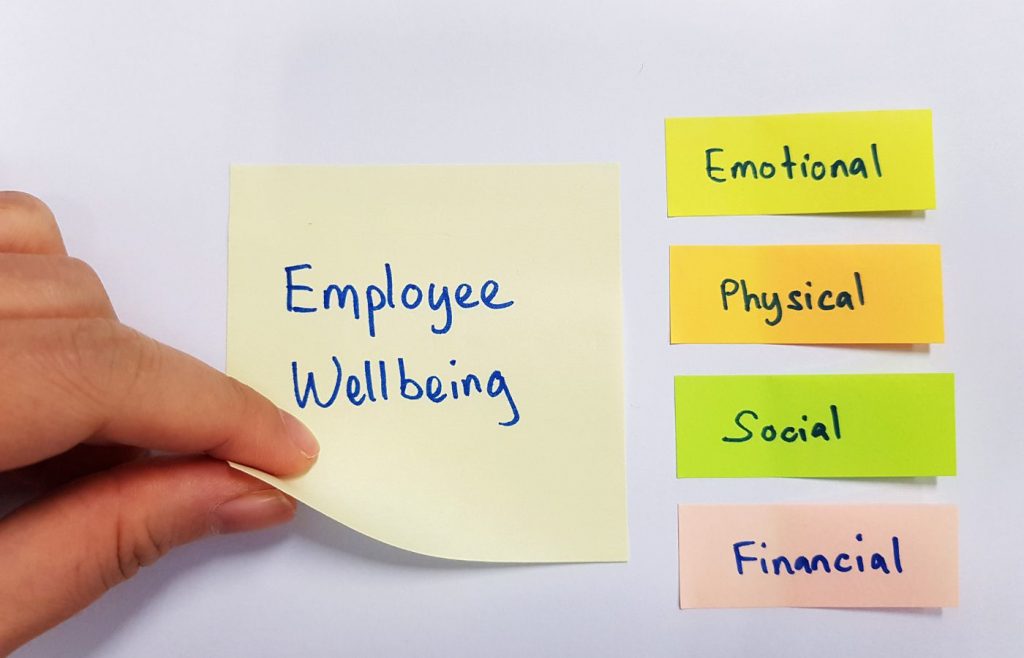Work structures and employee expectations are changing. The challenge for People & Culture experts now is to implement initiatives that not only attract top talent but also retain and engage existing teams. Creating well-defined employee wellness programs is not just a nice-to-have, it is a strategic investment towards the overall success of a company.
Prioritizing employee wellness is key for organizations striving to create a positive and productive work environment. This article serves as a comprehensive guide on employee wellness programs, from the 8 types that exist to 50 program examples to implement in the workplace. Learn how to design and implement employee wellness programs tailored to the unique needs and challenges of your workforce!
What is an employee wellness program
Nowadays, employee wellness programs are more than just a workplace trend; they are a strategic approach. An employee wellness program is a structured initiative focused on enhancing the overall health and wellbeing of employees. It goes beyond traditional health benefits and salary packages. These employee wellness programs aim to create a work environment that supports and enhances various facets of an employee’s life.
To create ideal employee wellness programs we must understand that a holistic employee wellness program addresses physical, mental, and social aspects of well-being. It creates a supportive environment that fosters healthier and happier employees.
Benefits of employee wellness programs
Employee wellness programs are the most intuitive initiatives to address the overall well-being of employees. They have become increasingly popular recently for very good reasons. Employee wellness programs:
- Improve physical health: employee wellness programs encourage people to adopt healthier lifestyles. This is done through different activities such as medical checkups, fitness challenges, or nutritional guidance, among others. These initiatives reduce health risks. It can also lead to lower healthcare costs for both employees and companies.
- Enhance mental wellbeing: mental health and stress management services contribute to a healthier workforce. Decreasing stress levels can have a great impact on productivity and satisfaction.
- Lead to higher productivity: when employees feel healthier and more engaged, they are more likely to better focus on their tasks and be more productive. Moreover, wellness programs can reduce absenteeism, also having a positive impact on productivity.
- Improve employee satisfaction: employees appreciate companies who invest in their wellbeing. A positive work environment boosts loyalty and engagement among employees.
- Power talent attraction: a company that organizes wellness initiatives for employees are more attractive to candidates. Employee wellness programs contribute to a positive employer brand, showing the company’s commitment to their employees health and wellbeing.
- Reduce other costs to companies: for example, investing in medical checkups can lead to early illness detection, therefore reducing healthcare expenses, insurance claims and medical leaves.
- Reinforce employee relationships: organizing wellness initiatives in which employees participate as a team helps to create a positive and supportive workplace culture. Those employees who participate often create stronger social bonds with their peers.
- Impact positively on the company culture: a company that organizes wellness programs reflects a company culture that values their employees health and wellbeing. Working on creating a positive culture can attract other individuals willing to contribute to a supportive work environment.
Types of employee wellness programs

Employee wellness programs are designed to address the diverse needs and preferences within employees. Needs and preferences are infinite, and so here you have the 8 most common demands from employees:
- Physical health programs: engaging employees in regular physical activities has the aim to improve their health and physical condition.
- Mental health programs: ensuring access to mental health resources and counseling is becoming increasingly common.
- Work-life balance programs: work structures have changed and so the preferences and necessities of the workforce.
- Team building programs: boosting social connections among the workforce has proved to be highly beneficial for both the company and the employees.
- Educative programs: the modern workforce is ambitious for knowledge and hungry to learn new skills and develop their careers.
- Programs dedicated to remote workers: 16% of companies worldwide are totally remote. This has resulted in the need to implement wellness programs for those employees who are not in the workplace.
- Programs dedicated to in-office workers: still, 44% of companies don’t allow employees to work remotely. Therefore, on-site wellness programs can still be an option for employees.
- Financial wellness programs: lifestyle has changed a lot in recent years. Rising living standards have made financial management problems a reality for many people.
50 Employee wellness programs examples
Let’s explore some innovative and effective employee wellness program examples that organizations have successfully implemented:
Employee wellness programs on physical health
- Weight loss challenges: create challenges to motivate employees to reach their weight loss goals.
- Sleep wellness programs: provide resources on establishing healthy sleep habits to improve sleep quality.
- Health challenges: introduce challenges with rewards for achieving health and wellness milestones.
- Hydration programs: provide water stations, challenges or educational resources on the benefits of drinking water and staying hydrated.
- Desk exercise programs: show employees short exercise routines or stretches that they can do at their desks.
- Exercise competitions: engage employees in friendly fitness competitions, such as step challenges to promote regular physical activity.
- Medical check-ups: organize on-site medical check-ups to encourage preventive health care practices.
Employee wellness programs on mental health
- Mindfulness meditation sessions: offer guided meditation sessions to promote relaxation and mindfulness and reduce stress.
- Mindfulness app subscriptions: offer subscriptions to meditation or mindfulness apps for employees to use at their convenience.
- Art and creativity workshops: offer employees access to creative activities like crafting, drawing or painting for stress relief.
- Employee assistance programs: provide access to confidential support, counseling services, and resources to address stress and mental health challenges.
- Technology detox days: encourage employees to take breaks from their computer and mobile phone to reduce screen time and promote overall well being.
- Diversity committee: build a diversity committee that spreads awareness about the importance of diversity, and the impact of racism, homophobia, and discrimination.
Employee wellness programs to promote work-life balance
- Flexible work schedules: allow employees to make their work schedules more flexible to better accommodate personal and family needs around work.
- Remote work: offer flexibility to work from home or in the office at the employee’s choice whenever possible.
- Promote smart working: combine remote work and flexible schedule. Give employees the freedom to choose their work space and schedule, in a way that suits their daily routine better.
- Parental support programs: offer resources and support for employees with children, such as childcare vouchers.
- Time-off benefits: encourage the use of vacation time and offer additional time-off benefits to promote relaxation and allow employees to attend to personal matters.
Team wellness programs
- Outdoor activities: organize outdoor team building activities to promote physical activity and team bonding.
- Social wellness events: organize social events, such as happy hours, to foster a sense of belonging to the community.
- Health and fitness challenges for teams: encourage teamwork through cooperative challenges to achieve fitness goals.
- Community engagement initiatives: support volunteer opportunities or community service projects to increase sense of purpose and social connection.
- Fitness community: create specific channels in your corporate communication tool where people who like the same sports can connect.
- Wellness trips: bring your teams together by organizing small day trips during the workday. Plans could include hiking in the woods, a day at the beach or a change of town for a special lunch.
Educative employee wellness programs
- Offer scholarships: facilitate employees’ access to university degrees or official courses to develop their skills.
- Competency development programs: prepare educational programs and career development plans focused on the competencies of your staff and offer refresher and training courses.
- Time management courses: organize educational programs on effective time management to improve productivity and reduce work stress.
- Conflict resolution training: prepare workshops that address communication skills and conflict resolution strategies to improve interpersonal relationships in the workplace.
- Diversity, equity and inclusion training: prepare workshops that promote DEI in the workplace.
- Leadership development programs: organize programs designed to improve leadership skills, including effective communication, strategic thinking, and team management.
- Public speaking courses: offers employees workshops aimed at improving public speaking and presentation skills, boosting confidence in the professional and personal spheres.
Wellness programs for remote workers
- Virtual training sessions: organize online training sessions so that employees can exercise from their own homes.
- Online nutritional workshops: organize virtual workshops on healthy eating habits, healthy cooking classes, or nutrition sessions to promote healthier food choices.
- Wellness apps: offer wellness apps and platforms to employees. Provide challenges, resources and tracking features to support employee wellness even if they are not working in the office.
- Wearable technology programs: send wearable devices and fitness trackers to employees and encourage them to monitor and improve their health metrics.
- Online nutritional workshops: offer educational sessions on nutrition, meal planning and healthy eating habits.
- Mental health seminars: organize online workshops focused on mindfulness and mental health dispositions to support stress management.
Wellness programs for in-office workers
- Ergonomic workstations: ensure that workstations are ergonomically designed to promote good posture and reduce physical strain.
- Stand-up or walk-around desks: offer employees the option of using stand-up or walk-around desks, encouraging movement during the workday.
- Healthy snack bar: set up a kitchen cabinet with nutritious snacks to encourage healthy eating habits.
- Bike-to-work programs: encourage employees to bike to work by offering amenities such as bike racks and showers.
- Gardening clubs: support employee wellbeing by organizing gardening clubs at the workplace.
- On-site fitness classes: conduct on-site classes or offer gym memberships to encourage employees to maintain an active lifestyle.
- On-site massage therapy: provide massage therapy services to help employees relax and relieve stress.
- Car sharing program: connecting people who need a ride with others who have space in their cars and live nearby.
- Relaxation areas: create a sofa room, a TV room or even an arcade or video game room for your employees to play together and relax after a hard day.
Financial wellness programs
- Financial education workshops: offer workshops on budgeting, investment strategies and financial planning to help employees achieve financial well-being.
- Employee financial assistance: consider offering financial assistance programs to employees facing financial hardship.
- Flexible remuneration: pay part of the salary on expenses you know employees must incur, like childcare, transport, gas, groceries or restaurants.
- Shareholder programs: if possible, offer employees the opportunity to hold and buy shares in your company.
Understanding the multifaceted nature of an employee wellness program is crucial when designing initiatives for the changing needs of your workforce. You can always tailor your wellness program to include a combination of these initiatives to meet the diverse needs and preferences of your employees.
How to create an employee wellness program
Employee wellness programs have evolved from being a nice-to-have perk to a strategic approach for companies aiming to create a healthier, happier, and more positive and productive workforce. Developing a wellness program that’s tailored to your employees lifestyle takes time, and unfortunately won’t be implemented overnight.
To be effective, implementing a wellness program requires careful planning:
- Send a survey to employees.
- Establish clear goals and objectives.
- List all proposals and decide.
- Get executives’ and team’s approval.
- Launch your initiatives.
- Monitor the employee wellness program.
1. Send a survey to employees
You will first need to conduct some research, through employee wellness surveys for example, to find out what specifically is important to the team. This will help you understand what the workforce could reasonably expect from an employee wellness program.
At this stage, it can be helpful to use an employee engagement tool. These types of tools allow you to deeply get to know your people and gather feedback from what they may wish for on a wellness program. Eventually, it will also help you monitor the program by sending periodic surveys for them to let you know their satisfaction levels with it.
Communication is a key ingredient to creating a successful company, and it’s also a key part of developing an effective employee wellness program. Make sure everyone in the team is informed of all the initiatives at their disposal, as well as any updates or changes.
2. Establish clear goals and objectives
Make yourself a question: what would you like the new employee wellness programs to impact? Motivation, health, satisfaction, work-life balance, etc. It’s time to define the overarching goals of your wellness program. And you must wonder, how would I know what needs to be addressed? Well, you’ve just sent a survey to all employees that will give you the keys.
- Do some employees claim flexible schedules and remote work? They will probably be looking for conciliation.
- Do some others ask for mental health consultations or mindfulness lessons? They would probably be facing stress.
Analyze your employees’ answers and extract the problems that exist within your workforce. Those have to be the goals of your employee wellness programs.
3. List all proposals and decide
After conducting the initial research, you’ll have a better idea of what your employees would most like to see included in the program. At this stage, remember to stick to the budget you’ve been given, to avoid making promises you won’t be able to fulfill. Extract a list of all proposals given by employees and estimate their cost and impact on the workforce. This will help you decide on those you can implement and those that are not so worthwhile.
The following questions can help you decide on which options would be more feasible to implement:
- Can you afford it financially
- Do you have enough resources to face it?
- Will it have a global impact on all or the vast majority of employees?
- Is this an initiative that could continue to work in the medium to long term?
- Is there any modality of this initiative that is more feasible or a better option?
If you’ve reached this point without clear ideas to implement or need additional ones, take a look at the section above with 50 employee wellness programs examples. There you’ll find a variety of types that you can easily implement.
4. Get executives’ and team’s approval
It’s easy to get carried away when thinking about what you want your ideal employee wellness program to look like. However, you must get employees’ and executives’ approval for it to be successful.
Ultimately, it’s imperative to get executives’ approval in order for the plan to get off the ground. Having management buy-in will help ensure that your program will go forward. When showing your proposals, it can be helpful to be transparent about why you’ve chosen the initiatives you have, and why you’ve missed out others. Providing the c-level and managers with this information will offer some context and reasoning for your approach.
However, it’s a fact that if you want your employee wellness program to be successful, employees must be engaged in the decision. We recommend that before launching any wellness initiative officially you prepare a survey to understand whether or not the initiative will be well received among your workforce.
5. Launch your initiatives
Once you’ve decided what to include in your employee wellness program, it’s time to consider the finer details and roll it out to the team. It’s important to clearly lay out the extent of the program, so none of the team miss out on any crucial information. You can use various channels such as emails, posters, company meetings, and the intranet to ensure employees are well-informed about the initiative. You can include all of this information in the employee handbook, so new employees are also informed.
6. Monitor the employee wellness program
Don’t forget to regularly check in on the progress and acceptance of the program, to ensure it’s continuing to benefit the employees. Be open to new ideas and take on board any feedback the team is willing to provide.
We recommend that you periodically send out employee engagement surveys, paying particular attention to the initiatives you have implemented. This will help you understand the impact it has on your workforce and you will be able to adjust it to benefit your employees more.
How to improve employee wellbeing
Designing and implementing an employee wellness program really helps to improve wellbeing. But it also helps to take care of the little details that we overlook in our daily routine in the workplace.
- Tip 1 > Foster open communication: make feedback a habit in your company to promote a more transparent and communicative workplace. You can open new communication channels for employees, anonymous or not. Think only of the ideal space for employees to share their needs and concerns in a safe space.
- Tip 2 > Maintain the number of employees necessary to accommodate the workload: high work demands – for example, long hours or pressure to work too hard or too fast – can have a considerable effect on employees’ health and well-being. When necessary, increase staffing levels to spread the demands. While it may seem costly, keep in mind that companies also pay when employees are exhausted or sick, absent or quit.
- Tip 3 > Cultivate supportive leadership: managers are responsible for 70% of employee engagement. In this sense, we draw from this that managers are the foundation of an employee’s well-being. Make sure managers know how to be good leaders.
- Tip 4 > Celebrate achievements: employee recognition in the workplace has to be a vital part of a company’s culture. Everyone feels better when their accomplishments are recognized. This is not necessarily linked to giving rewards; sometimes words are worth more than material things. Promote a positive recognition loop in your company; this creates a positive work environment which, in turn, boosts morale and improves employee wellbeing.
- Tip 5 > Give workers more control over their work: the combination of high job demands and poor job control severely affects not only job satisfaction and productivity, but health. Promote changes in worker autonomy. Even if they are relatively small, they can make a difference in their wellbeing.
- Tip 6 > Conduct regular performance reviews: a performance review is highly beneficial to employee wellbeing. Employees will get a sense of how they are doing in their position, identify areas for improvement, and have the opportunity to reflect on their work with a self-review. It is a great opportunity for your employees to get feedback that will motivate them to improve, enhancing how they feel in the workplace.
- Tip 7 > Create a customized wellness program for your employees: Now that you know how to create wellness programs, this may seem obvious. However, it is more common than you think for companies to implement the programs they think are best. Even if they launch employee surveys, they base their final decisions on mere suggestions.
Always remember that organizations that prioritize employee wellness create a healthier and more positive work environment. But it also contributes to increased engagement, retention and overall organizational success. Undoubtedly, employee wellness programs can help you with it, but don’t forget about the day-to-day things!










